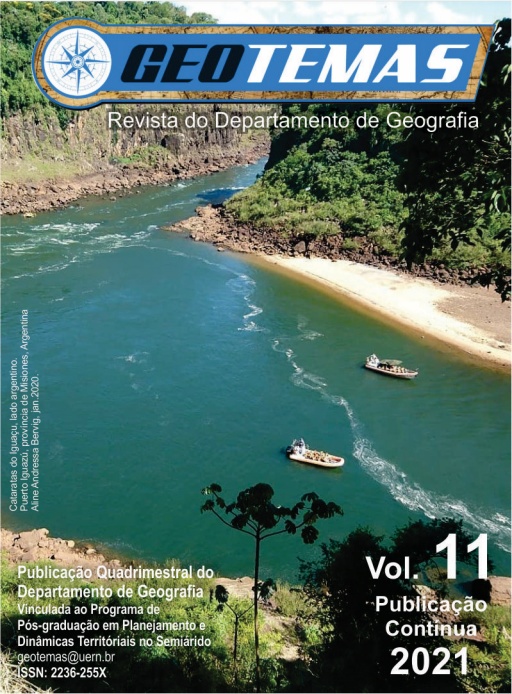Use of plants species in the treatment and cure of diseases by the tenharim indigenous in the Brazilian Amazon Rainforest
DOI:
https://doi.org/10.33237/2236-255X.2021.3264Keywords:
Ethnobotany, Traditional communities, Indigenous people of AmazonianAbstract
In this ethnobotany study accomplished in the Tenharim indigenous territory, located in the State of Amazonas, Brazil, through interviews was verified the use of more than 300 species plant, being most part of natural occurrence of the Amazon biome and the others introduced for several purposes, such as medicine, food, handicrafts, firewood, utensils and buildings in general. Among this great plant diversity, 104 species are used in the prophylactic and curative medicine of these indigenous. The objective of this study was to accomplish a gathering of the knowledge that Tenharim possess about the vegetation of their territory. The knowledge of the plants and man's relationship with the nature neither are passed or learned in a systematic or formal way among these natives, there are few that holden theese knowledge. The great variety of registered plant species demonstrated that the use of the plants is comprehensive, and very important in the cultural and ecological survival of the Tenharim.
Downloads
References
APG III. An update of the Angiosperm Phylogeny Group classification for the orders and families of flowering plants: APG III. Botanical Journal of the Linnean Society, v. 161, n. 2, p. 105-121. 2009.
ALCORN, J. The scope and aims of ethnobotany in a developing world. In: SCHULTES, R.E.; REIS, S. (ed.). Ethnobotany: evolution of a discipline. Portland: Dioscorides Press, p. 23-39, 1995.
AMOROZO, M. C. M. A abordagem etnobotânica na pesquisa de plantas medicinais. In: DI STASI, L. C. (org.). Plantas medicinais: Arte e Ciência, Um guia de estudo interdisciplinar. São Paulo: EDUSP, p. 47-68, 1996.
BETTS, V. Kagwahiva Dictionary. Anápolis: Associação Internacional de Linguística, 2012. 223 p.
CLAVAL, P. As Abordagens da Geografia Cultural. In: CASTRO, E. I.; GOMES, P. C. C.; CORRÊA, R. L. (org.). Explorações Geográficas - percursos no fim do século. Rio de Janeiro: Bertrand Brasil, p. 89-117, 1997.
DIEGUES, A. C.; ARRUDA, R. S. V.; SILVA, V. C. F.; FIGOLS, F. A. B.; ANDRADE, D. Os saberes tradicionais e a biodiversidade no Brasil. São Paulo: MMA/COBIO/NUPAUB/USP. 2000. 211 p.
ESCOBAR, A. L.; COIMBRA JR., C. E. A; CAMACHO, L. A.; PORTELA, M. C. Tuberculose em populações indígenas de Rondônia, Amazônia, Brasil. Caderno de Saúde Pública, Rio de Janeiro, v. 17, n. 2, p. 285-298, 2001.
FLORA BRASILIENSIS. 2015. http://florabrasiliensis.cria.org.br/project.
IBGE. Instituto Brasileiro de Geografia e Estatística. Manual técnico da vegetação brasileira. Rio de Janeiro: IBGE, 2012. 271 p.
ISA. Instituto Socioambiental. Terras Indígenas no Brasil. Versão março/2018. Disponível em: https://www.socioambiental.org/pt-br
LÉVÊQUE, C. La biodiversité. Paris: Presses Universitaires de France, 1997. 128 p.
LÉVI-STRAUSS, C. As organizações dualistas existem? In: Antropologia estrutural. São Paulo: Cosac Naify, p. 147-178, 2008.
MENÉNDEZ, M. A. Os Kawahiwa: uma contribuição para o estudo dos tupi centrais. 1989. Tese (Doutorado em Antropologia Social) – Universidade de São Paulo, Faculdade de Filosofia, Letras e Ciências Humanas, São Paulo. 1989.
MINAYO, M. C.; SANCHES, O. Quantitativo-qualitativo: oposição ou complementaridade? Caderno de Saúde Pública, Rio de Janeiro, v. 3, n. 9, p. 239-262, 1993.
MINNIS, P. E. Ethnobotany. Norman: University of Oklahoma Press, 2000. 327 p.
PEGGION, E. A. Ritual e vida cotidiana no sul do Amazonas: os Tenharim do rio Marmelos. Perspectivas, São Paulo, v. 29, p. 149-168, 2006.
SALVI, R. M.; HEUSER, E. D. Interações medicamentos x fitoterápicos: em busca de uma prescrição racional. Porto Alegre: EDIPUCRS, 2008. 116 p.
SILVA, R. A. Os tenharim: a pessoa, o corpo e a festa. 2006. 173 f. Dissertação (Mestrado em Sociologia) - Universidade Estadual Paulista, Faculdade de Ciências e Letras, Araraquara. 2006.
VELOSO, H. P. Sistema fitogeográfico. In: Manual técnico da vegetação brasileira. Rio de Janeiro: Fundação Instituto Brasileiro de Geografia e Estatística, p. 9-38. 1992.
VIERTLER, R. B. Métodos Antropológicos como ferramenta para estudos em etnobiologia e etnoecologia. In: AMOROZO, M. C. M.; MING, L. C.; SILVA, S. M. P. (org.). Métodos de coleta e análise de dados em etnobiologia, etnoecologia e disciplinas correlatas. Rio Claro: Universidade Estadual Paulista, p. 12-29, 2002.
Downloads
Published
How to Cite
Issue
Section
License
Copyright (c) 2021 JOURNAL GEOTEMAS

This work is licensed under a Creative Commons Attribution-NonCommercial 4.0 International License.
Authors who submit their manuscripts to Geotemas declare that the work is an original article and has not been submitted for publication, in full or in part, in another national or international scientific journal or in another circulation vehicle. The authors also declare that they agree with the transfer of the copyright of the referred article to the magazine Geotemas (University of the State of Rio Grande do Norte), allowing for later publications, as long as the source of its publication is assured. Finally, they assume public responsibility for the article, being aware that any charges arising from a claim by third parties regarding the authorship of the work may apply to them.



















